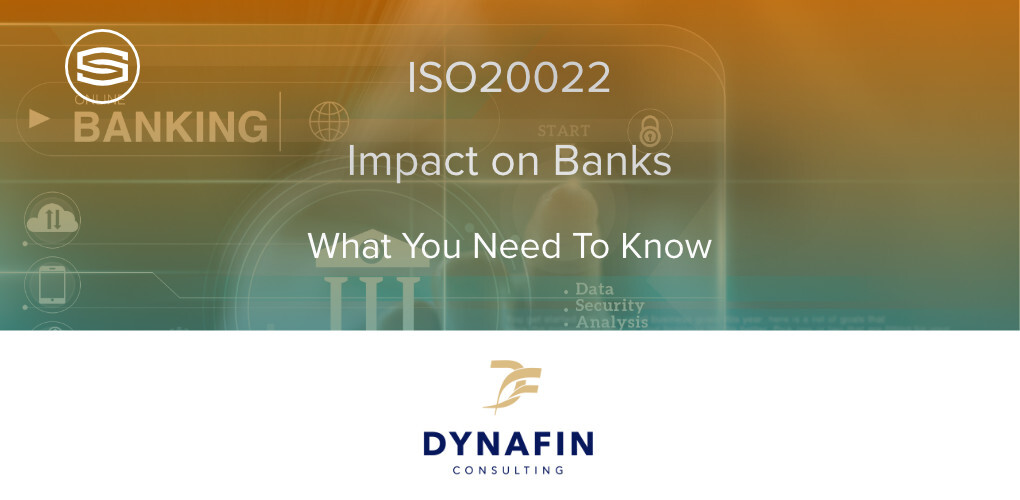
Insights & Opinions
ISO20022 Impact on Banks - What You Need To Know
Thu, 07 Dec 2023


It feels like the banking industry has been focussing much attention on the ISO20022 compliance deadline of November 2025, but less on the benefits that this new messaging standard will bring. Viewing the migration in a more strategic manner uncovers benefits beyond internal process efficiency.
Christophe Wauthier, Director, DynaFin Consulting, shares what you need to know about this significant change on the horizon.
ISO 20022 Message Standard - Introduction
The financial sector faces a major change with the migration of the ISO messages from MT to MX standards. ISO 20022, the foundation of the MX standard, uses an XML-based structure, which is more flexible and has more data fields than the traditional MT standard. This standard enables the transmission of richer, more structured data, paving the way for better data analysis, enhanced compliance capabilities, and improved transaction processing efficiency.
The ISO20022 framework introduces a universally shared language in financial messaging, improving interactions across global financial institutions. Major Financial Institutions and central banks worldwide don’t see this migration as a routine operational change, but a strategic move towards a more integrated and transparent financial ecosystem. The ongoing migration therefore marks a significant milestone in global financial communication.
ISO 20022 - Differences with Previous Standards
ISO 20022 marks a significant upgrade from older financial messaging systems. In the past, different systems like ISO 15022, ISO 8583, and others used their own unique formats for sending financial information. This was like having many different dialects in the same language – understandable but not always clear or efficient. It slowed down the integration and transparency of global financial messaging and transaction processing.
ISO 20022 introduces a uniform language for the financial world with a well-formed approach that enables consistency across multiple transaction types and businesses. This new format can be compared to writing a well-structured letter instead of a chaotic note. The structure helps computers process financial information more easily and accurately, leading to fewer mistakes and more automation opportunities.
This universal language offers a framework that permits interoperability, making it straightforward for financial institutions to carry out complicated transactions across platforms. After fully adopting this new standard, translation services for incoming and outgoing messages can be phased out over time.
Data protection is also a key area of improvement with ISO 20022 compared to its predecessor, ISO 15022. The XML-based format of ISO 20022 includes advanced security features like digital signatures, encryption, and authentication codes directly within the message structure. These elements add additional layers of security, safeguarding sensitive information against unauthorised access or modification – a critical feature in today’s landscape of ongoing cybersecurity threats.
These improvements will ensure financial institutions can process their transactions faster, with higher quality and less effort. It also means they can better manage operational and financial risks because they have more precise and more complete information at their fingertips.
In simple terms, ISO 20022 makes financial communication faster, cheaper, and safer.
ISO20022 - Challenges of Message Standards Co-Existence and Migration
Adopting ISO 20022 is a complex and lengthy task, similar to integrating a more advanced and efficient system alongside an existing one. During the initial phase, banks will operate the legacy communication systems and the new ISO 20022 framework in parallel. This phase is a critical challenge, requiring compatibility and smooth communication between the two systems. Banks and finance institutions must fine-tune their operations to handle both formats effectively and ensure there is no disruption to service.
This transition to ISO 20022 typically requires an overhaul of existing IT infrastructures in financial institutions, as the new standard requires different data formats, communication protocols, and processing capabilities compared to older systems. Ensuring compatibility can be complex and costly, with reviews, upgrades and sometimes replacements of legacy systems, integrating new software solutions, and ensuring that these solutions communicate effectively with the new standard.
The transition to ISO 20022 enables handling more granular and structured data, so banks will need to increase their data management capabilities. This upgrade is substantial – it involves moving from a more limited and less flexible data handling system, to a robust and sophisticated digital framework capable of processing and storing a wide range of detailed financial information.
Financial institutions must navigate the regulatory landscape associated with adopting ISO 20022. This is a challenging balance of maintaining operational continuity and ensuring regulatory compliance. The overall objective during this transition is to strengthen the security and efficiency of customer transactions, aligning with the enhanced capabilities of ISO 20022 to deliver superior service quality and reliability in financial communications.
While ISO 20022 provides a standardised approach, some level of customisation may be required to fit the specific needs of each institution, adding complexity to the implementation process. This customisation can involve tweaking the standard to fit specific product offerings; client needs, or regional regulatory requirements and developing interfaces or middleware for smooth integration with existing internal systems.
ISO20022 : DynaFin and Satisco – Conversion, Transition and Migration Solutions
In this challenging environment, DynaFin proposes its ISO20022 Business Consulting solutions to the market (advise – design – deliver) and deploys the "Satisco Application Integration (SAI)” solution which is a key enabler for a seamless migration.
Designed to bridge the gap between MT and MX, SAI uses advanced IBM tools such as IBM Transformation Extender (ITX) and IBM Sterling B2B Integration to ensure a fast and efficient, smooth and seamless transition.
Key features of SAI include:
- Automated Conversion: Automated tools for converting MT to MX messages (and vice versa), ensuring consistency and accuracy.
- Transition Management: Intelligent systems to manage the co-existence of old and new formats during the transition period.
- System Compatibility: SAI is designed to integrate easily with various existing environments, ensuring a smooth transition.
- Advanced Business Monitoring: Real-time monitoring tools (adapted to business users) to oversee messaging operations, enhancing security and reliability.
- Efficient Onboarding: Simplified processes for connecting with all financial partners, ensuring continuous and secure communication.
SAI not only addresses the technical aspects of migration but also supports organizations in managing operational changes, ensuring that the transition to ISO 20022 is both effective and efficient. As the financial world moves towards ISO 20022, solutions like SAI become invaluable for institutions aiming to navigate this transition smoothly.
By understanding and using these solutions, banking professionals can effectively meet the challenges of the new era of financial messaging and achieve compliance and a competitive advantage.
* DynaFin and Satisco are both part of the Alan Allman Associates EcoSystem - https://alan-allman.com/ - Euronext Paris FR0000062465



